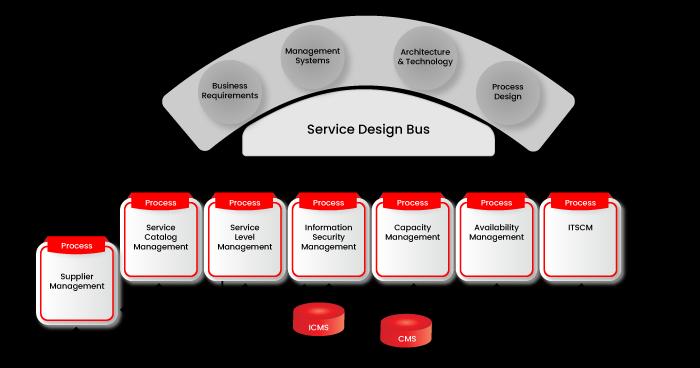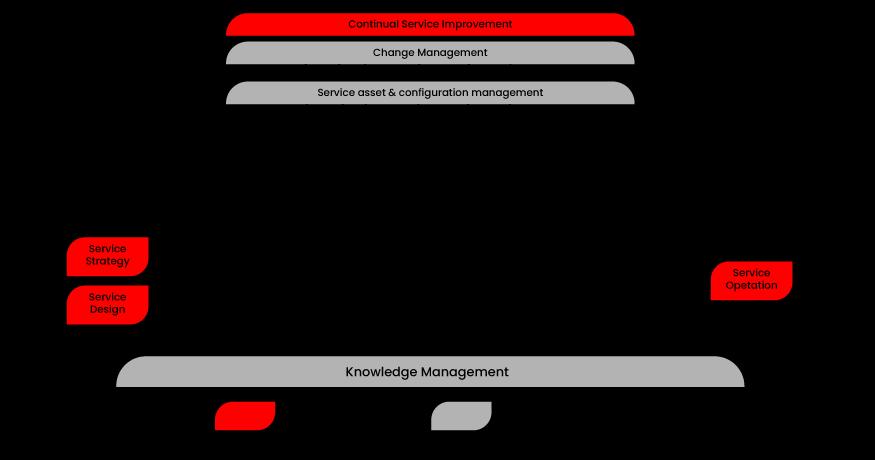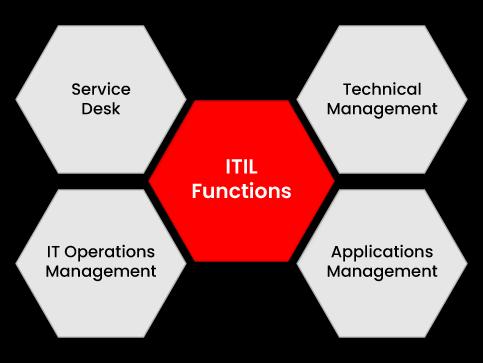- Home
- Blog
- ServiceNow
- What is ServiceNow ITIL - A Complete Overview

- ServiceNow Interview Questions and Answers
- What is ServiceNow Ticketing Tool
- ServiceNow Tutorial
- Top 10 IT Management Tools
- What is Servicenow Workflow
- ServiceNow Admin Interview Questions and Answers
- What is ServiceNow - A Complete Guide for Beginners
- What is ServiceNow GRC
- ServiceNow Reporting
- ServiceNow Data Model
- What is ServiceNow Orchestration
- ServiceNow vs Jira Service Management
- ServiceNow Architecture
- SLA ServiceNow
- ServiceNow Webassessor
- ServiceNow Integration With Jira
- ServiceNow Scripting Interview Questions
ServiceNow ITIL is the series of IT Service Management to align the services and operations. It includes tasks, checklists, processes, and procedures that are not inevitably particular to an enterprise or the technology but are yet applicable towards enterprise strategies by maintaining competency and delivering values.
Initially, ITIL was introduced to enhance the IT service management for the UK central government, it has transformed into a standard for various enterprises; private or public sector, distributed, or centralized. To learn more about ServiceNow ITIL, Join our ITIL training. This ServiceNow ITIL introduces you to the basics of ServiceNow ITIL and tells you how you can enhance your business through ServiceNow ITIL.
| Table of Content - ServiceNow ITIL |
What is ServiceNow ITIL?
ServiceNow ITIL is the integrated and process-based framework to handle IT services. It offers guidance to create and operate the service desk that effectively communicates between IT providers and the user community.
| If you want to enrich your career and become a professional in ServiceNow, then enroll in "ServiceNow Online Course - This course will help you to achieve excellence in this domain. |
Why is ITIL important?
ITIL was released by AXELOS Limited, offers suggestions and a framework that is extensively adopted by several organizations which are obtaining the advantages of the standardized approach. ITIL framework enhances the quality of the service management, operation, and outcomes of the enterprises that select to commit to the ITIL framework.
How can ITIL help your business?
ITIL framework includes demonstrated methodologies for how enterprises can maximize their ITSM for change and growth. ITIL is about adapting and adopting, not the cover application of one limited group of activities.
Enterprise Advantages of ITIL
- It allows the IT organizations to be autonomous over handling business issues instead of IT issues.
- It decreases IT operations costs.
- It enhances employee satisfaction and IT productivity.
- It defines cost-efficient practices.
- It develops a stable environment that enables scale, change, and growth.
- It helps in handling risk, failure, and disruption.
- It reinforces the user relationships by giving effective services that satisfy their requirements.
What is ITIL4?
ITIL4 is the new version of ITIL. It offers a digital operating model that allows enterprises to create efficient value from their IT-supported services and products. It develops on ITIL’s decades of development, progressing setup ITSM practices for a broader perspective of the values streams, customer experience, and digital transformation. ITIL 4 also endorses larger alignment with new methods of working like DevOps, Agile, and Lean, for co-creating the business value.
How ServiceNow ITIL works?
The ITIL framework has five stages in the lifecycle. But ServiceNow endorses only three of those stages - service operation, service design, and service transition. The other stages that ServiceNow does not support are continual service improvement and service strategy.
#1. Service Strategy
This is the beginning stage of ITIL. It allows us to get the idea of the design, implementation, and development of the service. We can develop a blueprint or roadmap for the new IT service.
#2. Service Design
After exhibiting the plan for our service, the next phase is designing. It is the primary block to build the model. We have to ensure that we make the best design for service. This is where we develop the architecture of service tasks. We must list the policies, solutions, and processes for the service.

#3. Service Transition
This phase is helpful for maintaining, planning, deploying, and deploying the latest or changed IT service into production. We must list out back out and risk management plans. According to the requirements, we must make modifications to the management process.

#4. Service Operation
In this phase, we manage the deliveries. We must verify the quality of the service and assure that an effective service is being provided to the end-user. We can resolve incidents and monitor services.
#5. Continual Service Improvement
This is the final phase of ITIL. It can monitor the continuous delivery of the services to the clients without impacting the other systems in the framework. It can also identify the approaches for enhancing the overall effectiveness.
ServiceNow ITIL Processes
ITIL offers various processes that we can classify into three service concepts. Following are the service concepts :
Service Design
In-Service Design, we design the architecture of the new or latest service based on the service strategy. It also establishes the policies, solutions, and processes on the basis of business needs. Processes:
- Availability Management
- Supplier Management
- Service Level Management
- Capacity Management
- Service Catalog Management
Service Transition
The main objective of this service is to plan, handle, develop and deploy the latest or modified IT service in production. It also outlines the backout and risk management plans. Processes:
- Knowledge Management
- Configuration Management
- Change Management
- Release Management
- Asset Management
| Check out ServiceNow Developer Instance |
Service Operation
It delivers regular IT services to the customers. It assures that all the IT services are provided effectively without any disruption. Processes:
- Incident Management
- Event Management
- Request Fulfill Management
- Facilities Service Automation
- Problem Management
Following are some important processes
- Change Management: It is the approach that directs on how to prepare, support, and handle in the service. It handles any type of change in the organization. It can be process change, technological change, physical data center, and organizational restructuring.
- Incident Management: It is the approach for identifying, managing, and analyzing the disruption designed in the service. Incident management assures that the performance of service is sufficient and interruptions in service quality are recovered as early as possible.
- Problem Management: The main purpose of problem management is to find a permanent root cause to recur the incidents. Problem Management eliminates the effect of the recurring incidents in services. According to the ITIL practice, the problem record is elevated for recurring incidents.
| Preparing for ServiceNow Interview? Here’s Top ServiceNow Interview Questions and Answers |
Comparison between ITSM and ITIL
|
ITSM |
ITIL |
|
ITSM utilizes the ITIL framework with other business viewpoints for delivering IT services. |
ITIL is the framework that offers the best practices for implementing ITSM |
|
ITSM is focused mainly on the entire business. |
ITIL is focused on the internal team. |
|
ITSM defines what has to be done. |
ITIL defines how it has to be done. |
|
ITSM offers the methodologies to manage the service. |
ITIL offers tools and techniques for providing those services. |
|
ITSM is the implementation of the entire service. |
ITIL offers a group of process standards. |
Advantages of using ServiceNow ITIL
Following are some of the advantages of using ServiceNow ITIL:
- It allows us to develop an evident capability model that coordinates with enterprise strategy.
- It assures that the customer service requirements are satisfied.
- It offers standard tools and language that provide coordination within the IT teams.
- It also offers a flexible and practical basis for digitally transforming the organization.
- It assists in coordinating the physical, digital, and human resources to work scope.
- It offers a comprehensive approach to delivering services and products.
- It enhances the transparency and coordination in the teams.
- It comprises repeatable and consistent processes.
- It assists in navigating using the existing changes in services.
- It endorses the rapid quality and value-driven distribution of services.
- It decreases the costs by enhancing the consumption of resources.
- It delivers the best management service disruption, business failure, or risk.
- It also provides a stable environment that endorses continuously progressing business services.
- It assures perfection in the operating of all the services by eliminating the obstacles.
- The assurance for the longevity and reliability of the performance is offered.
- It sets cost-efficient solutions to manage the services.
Conclusion
The full form of ITIL is Information Technology Infrastructure Library(ITIL) and it was developed by CCTA(Central Computer Telecommunications Agency) of the UK government. ITIL specifies the services as a “process of providing value to the customers by alleviating the outcomes users have to achieve, but without controlling the particular risks and costs.” I hope this ServiceNow ITIL article provides the required information about ServiceNow ITIL.
 On-Job Support Service
On-Job Support Service
Online Work Support for your on-job roles.

Our work-support plans provide precise options as per your project tasks. Whether you are a newbie or an experienced professional seeking assistance in completing project tasks, we are here with the following plans to meet your custom needs:
- Pay Per Hour
- Pay Per Week
- Monthly

Madhuri is a Senior Content Creator at MindMajix. She has written about a range of different topics on various technologies, which include, Splunk, Tensorflow, Selenium, and CEH. She spends most of her time researching on technology, and startups. Connect with her via LinkedIn and Twitter .

